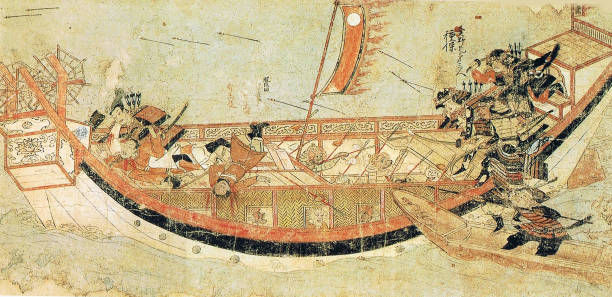The Mongol Invasions: How Kamikaze Winds Saved Japan
- torinaga11
- Nov 13, 2024
- 5 min read

The Mongol Invasions of Japan, which took place in 1274 and 1281, stand as one of the most remarkable episodes in Japan’s history, where divine winds, or "Kamikaze," played a critical role in defending the Japanese islands from the forces of the mighty Mongol Empire. Under the command of Kublai Khan, grandson of Genghis Khan, the Mongols had expanded their territory to encompass much of Asia and parts of Europe, marking them as one of the largest and most powerful empires in history. Japan, an isolated island nation, seemed a likely next conquest for the ambitious Mongol ruler. However, two legendary storms would thwart the Mongol efforts and go on to cement the concept of “Kamikaze” in Japanese culture and folklore.
The Background of the Mongol Invasions
The first contact between Japan and the Mongols began in 1266 when Kublai Khan, after consolidating his power in China, sent envoys to Japan demanding its submission as a Mongol tributary. The shogunate (Japan’s military government), however, rejected Kublai Khan’s demands, refusing to acknowledge the Mongols' dominance. Unmoved by Japan's rejection, Kublai Khan planned a full-scale invasion.
Kublai Khan’s choice to invade Japan was not merely to expand his empire, but to demonstrate Mongol power. He saw Japan as a potential ally or subject that would further his control over East Asia. Japan’s refusal not only hindered Kublai's ambitions but also represented a defiance that the Mongol ruler was not willing to tolerate.

The First Invasion: The Battle of Bun'ei (1274)
In 1274, Kublai Khan launched his first invasion attempt, known as the Battle of Bun'ei. The Mongol forces consisted of approximately 23,000 troops, including Chinese, Mongol, and Korean soldiers, as well as over 800 ships. They landed on the shores of Kyushu, Japan’s southernmost main island, quickly overwhelming the local samurai forces.
The Mongol forces brought with them advanced weaponry, including exploding bombs and incendiary arrows, which were new to the Japanese. The sheer force and tactical innovation of the Mongol military initially threw the Japanese defenses into disarray. However, the Japanese fought valiantly to defend their land, employing their knowledge of the terrain to counter the Mongol advantage.
As the battle reached a tense stalemate, a powerful storm suddenly appeared. The Mongol fleet, unused to Japan's weather patterns and lacking experience with typhoons, was caught off guard. The violent winds and waves destroyed a large part of the Mongol fleet, forcing the invaders to retreat. The Japanese interpreted this as an act of divine intervention, coining the term "Kamikaze" or "divine wind" to describe the phenomenon.

Preparations for the Second Invasion
Unwilling to accept defeat, Kublai Khan spent the next several years preparing for a second, more extensive invasion. This time, he mobilized a massive force estimated at over 140,000 troops, gathered from across his vast empire, including skilled sailors and soldiers from China and Korea. The fleet was significantly larger, with an estimated 4,400 ships, many of which were Chinese-style sailing vessels unsuited for rough sea conditions.
During this time, Japan, fully aware of the impending threat, made serious preparations for the expected invasion. Under the leadership of the shogunate, defensive walls and fortifications were constructed along the coast of Kyushu. Samurai were stationed to guard potential landing sites, and the Japanese resolved to fight to the last man to protect their homeland.
The Second Invasion: The Battle of Koan (1281)
In 1281, Kublai Khan launched his second invasion. The Mongol fleet approached Japan in two divisions, one sailing from Korea and the other from southern China. The plan was to join forces at Iki and Tsushima islands before proceeding to mainland Japan. However, logistical issues and miscommunications led to delays, leaving the Mongol fleet vulnerable and disorganized.
Once again, the Mongol forces encountered fierce resistance from the Japanese. The samurai, fighting on their home soil, used guerrilla tactics to disrupt the Mongol forces, taking advantage of the terrain and employing defensive walls to protect themselves against Mongol weaponry. The Japanese were better prepared this time, having learned from the experience of the first invasion.
As the battle raged on, an unexpected typhoon swept through the region, just as it had seven years earlier. The storm struck with immense force, and the Mongol fleet, anchored in exposed waters, was devastated by the brutal winds and waves. Thousands of Mongol soldiers drowned, their ships splintered and scattered. Once again, the “Kamikaze” had saved Japan.

The Significance of the Kamikaze
The Kamikaze typhoons that thwarted the Mongol invasions became more than just a historical phenomenon; they became a symbol of Japan’s resilience and divine protection. To the Japanese, these “divine winds” were proof that their land was protected by the gods, reinforcing a strong sense of national identity and a belief in the sanctity of Japan’s sovereignty. The storms became part of Japanese lore, embodying a supernatural shield that kept foreign enemies at bay.
The Kamikaze also influenced Japanese military and cultural ideology for centuries to come. In World War II, the term “Kamikaze” was revived to describe suicide pilots who willingly sacrificed their lives to protect Japan from foreign invasion. While the circumstances were vastly different, the use of the term evoked the same spirit of selfless defense of the homeland.
The Mongol Invasions’ Impact on Japan
Though the invasions failed, they left a lasting impact on Japan. First, the invasions underscored the need for Japan to maintain and strengthen its defenses, especially in the face of foreign threats. The construction of coastal fortifications, combined with the discipline of the samurai warrior class, marked a pivotal shift in Japan’s military strategy.
Furthermore, the invasions had a significant effect on Japan’s culture. The idea of Kamikaze fostered a sense of unity and a belief in divine protection, reinforcing the idea that Japan was a sacred land. This sense of cultural and spiritual resilience played an essential role in shaping Japan’s national identity and contributed to its ethos of loyalty, sacrifice, and honor.

The Legacy of the Kamikaze in Japanese History
The Mongol invasions and the Kamikaze storms have left a legacy that endures in Japanese historical consciousness. The notion that Japan is uniquely protected by divine forces is deeply ingrained in Japanese mythology and nationalism. For centuries, Japanese poets, artists, and writers have depicted the Kamikaze as a symbol of Japan’s invincibility.
The story of the Kamikaze winds, like many historical legends, combines elements of myth and reality. Although modern science explains the typhoons as natural seasonal weather events, for the Japanese people, these storms were and continue to be symbols of divine intervention. The Mongol invasions and the Kamikaze winds serve as a reminder of Japan’s enduring strength and resilience, inspiring generations to uphold the values of courage, loyalty, and unwavering dedication to their homeland.
The Mongol invasions of Japan in 1274 and 1281 stand as remarkable chapters in history, illustrating how nature’s forces can alter the course of human events. The "Kamikaze" storms that swept away Kublai Khan’s formidable fleets are remembered as a miraculous intervention that preserved Japan's sovereignty. These divine winds forged a resilient national spirit and left an indelible mark on Japanese identity, reminding future generations of the power of perseverance and the mystical forces that protect the island nation. The story of the Kamikaze is a timeless tale of defiance against overwhelming odds and remains an enduring symbol of hope, strength, and divine protection in Japan’s historical narrative.
#MongolInvasions #Kamikaze #DivineWinds #JapaneseHistory #KublaiKhan #SamuraiSpirit #JapanCulture #TyphoonDefense #NationalIdentity #HistoricalLegends #JapanResilience #DivineIntervention #BattleOfBunei #BattleOfKoan #AncientJapan #CulturalHeritage #IslandNation #MythAndHistory #JapanLegacy #HistoricalJapan


Comments